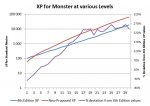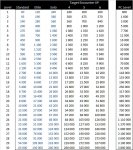In the last battle of my Loudwater campaign, Orcus (level 34 Solo) was automatically taking a 29th level PC to 0 hp *every round* with the Wand of Orcus, plus re-animating all his undead minions every round.
He still went down fairly easily, and no PCs died. Being taken to 0 hp didn't seem to bother the PCs much, they had several self-healing no-action abilities before even getting into Leader healing. So it seemed like it almost did not matter what damage the monsters can do, unless they can negative-bloody a PC in one attack routine.
He still went down fairly easily, and no PCs died. Being taken to 0 hp didn't seem to bother the PCs much, they had several self-healing no-action abilities before even getting into Leader healing. So it seemed like it almost did not matter what damage the monsters can do, unless they can negative-bloody a PC in one attack routine.









